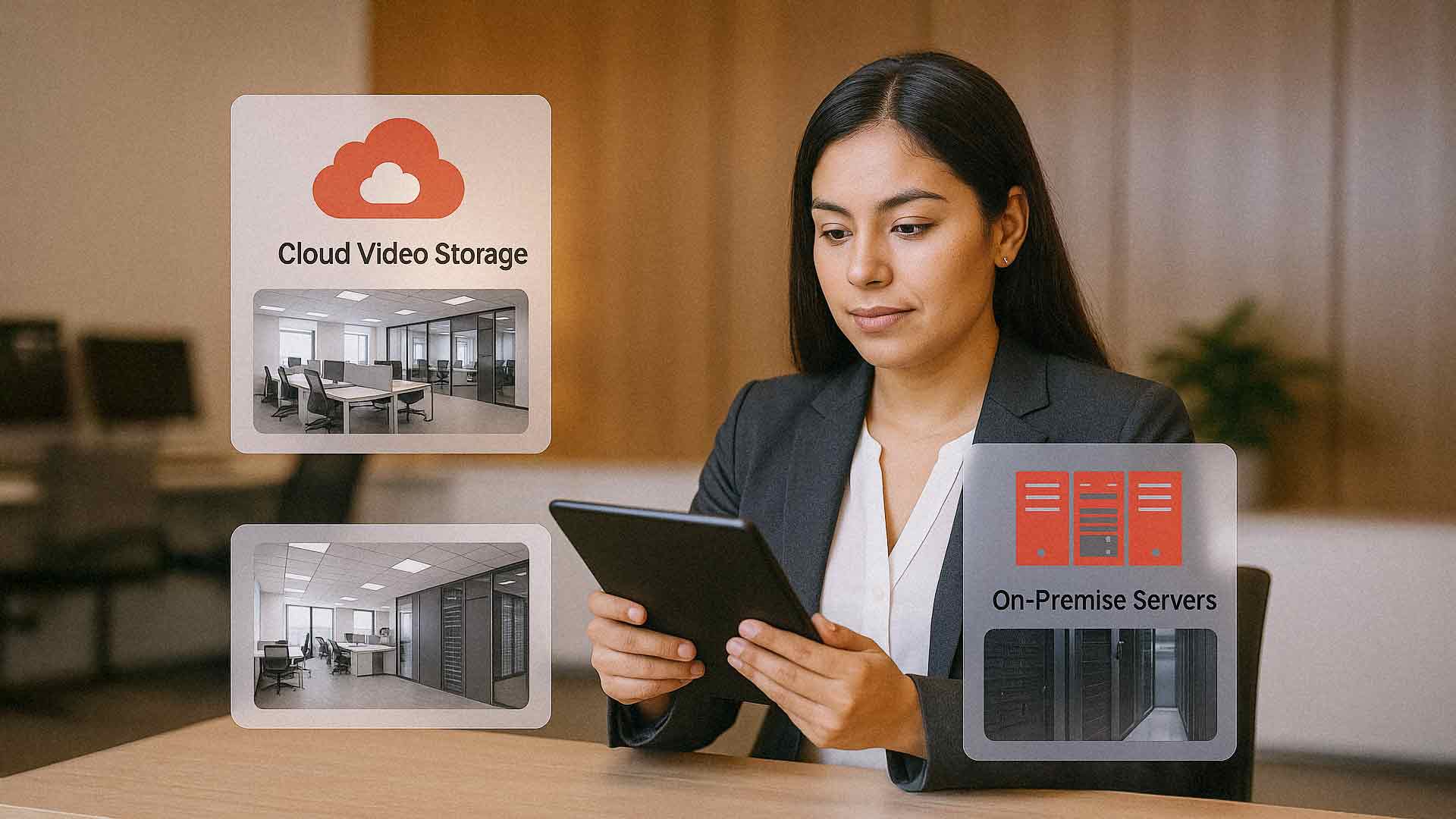Cloud vs On-Site Video Storage: Total Cost Comparison Over 5 Years
September 30th, 2025 | 6 min. read

Your video surveillance system is only as good as your storage.
Whether you’re upgrading cameras, planning a new installation, or rethinking your security strategy, one of the biggest decisions you’ll face is this:
Should we store our video footage in the cloud or keep it on-site?
The answer depends on more than just your budget this year. You need to consider the total cost of ownership over time, the specific needs of your business, and the level of control or flexibility you desire in your security infrastructure.
In this article, we’ll break down:
- What cloud and on-site storage actually cost
- What each includes (and what it doesn’t)
- Where the hidden costs hide
- And how to think about this decision over a 5-year timeline
Why Video Storage Matters More Than Ever
Video footage has become essential for more than just security. Today’s businesses rely on it for:
- Liability protection
- Customer dispute resolution
- Workplace safety monitoring
- Compliance with internal policies or external regulations
At the same time, camera resolution is increasing, which means larger files and higher storage demands.
Storing 1080p or 4K footage for 30 to 90 days across multiple cameras adds up quickly. That makes your storage strategy just as important as the cameras themselves.
Cloud Video Storage: What It Costs and What You Get
Core Costs
Most cloud-based video storage platforms charge a monthly or annual fee per camera. The fee usually depends on:
- Number of days you want to retain footage
- Resolution of stored video
- Cloud provider features (AI, analytics, mobile access)
Typical costs range from:
- $10–$30 per camera per month for basic plans
- More for extended retention, 4K resolution, or analytics
Example: A 16-camera system storing HD video for 30 days might cost around $3,800–$5,500 per year.
Hidden or Variable Costs
Cloud seems simple, but there are factors to watch out for:
- Bandwidth requirements: Constantly uploading video streams requires a strong, reliable internet connection. You may need to upgrade your connection, especially if you have a lot of cameras.
- Storage overage fees: If you exceed retention or add cameras, fees grow quickly.
- License creep: As platforms add features, costs may rise annually.
Benefits
- No local hardware to manage, replace, or troubleshoot
- Remote access from any device with proper credentials
- Built-in redundancy: no risk of a failed hard drive losing your data
- Faster, easier retrieval and sharing of footage
On-Site Video Storage: What It Costs and What You Get
Core Costs
On-premise video storage usually involves:
- A network video recorder (NVR) or digital video recorder (DVR)
- Hard drives or storage arrays sized to your retention and resolution needs
- Video management software (may include per-camera licensing)
Upfront investment might range from $3,000 to $10,000 or more, depending on:
- Number of cameras
- Desired retention length
- Storage type and capacity
This is a one-time capital expense, although some software licenses may require renewals or upgrades over time.
Ongoing Costs
- Maintenance and repair: Hard drives fail, and hardware becomes outdated. Plan for replacements around year 4 or 5.
- Power and cooling: These devices run 24/7 and may add load to your electrical systems.
- Support: Either internal IT or an outside vendor must manage updates, troubleshooting, and storage planning.
Benefits
- One-time purchase with no monthly fees
- Full control over storage, access, and retention policies
- No reliance on the internet for recording or viewing footage
5-Year Cost Comparison: Cloud vs On-Premise
Let’s look at a typical example:
A 16-camera system recording HD video with 30-day retention.
|
Cost Element |
Cloud Storage |
On-Site Storage |
|
Year 1 |
$4,000 (subscription + setup) |
$6,500 (hardware + install) |
|
Annual Cost (Years 2–5) |
$3,500 |
$500 (support, power) |
|
5-Year Total |
$18,000 |
$8,500 |
Note: These numbers are general estimates. Actual pricing varies based on vendors, features, support, and local installation labor.
Analysis:
- Cloud looks cheaper up front, but long-term fees add up
- On-site requires more up-front cash but becomes more cost-efficient over time
- If your team can manage the equipment on-site, it may reduce your total cost significantly
Which Option Is Better for Your Business?
There is no one-size-fits-all answer. Here’s a quick guide based on business needs:
Cloud is a better fit if you:
- Need remote access to video footage from multiple locations
- Don’t want to manage on-site servers or deal with hardware maintenance
- Plan to scale up or add more locations over time
- Want built-in redundancy and off-site backup for disaster recovery
On-Site is a better fit if you:
- Have limited bandwidth or unreliable internet
- Need full control over video retention, access, or privacy
- Work in a high-security or compliance-heavy industry
- Prefer a one-time investment instead of recurring monthly fees
For many businesses, a hybrid approach works best: storing recent footage on-site for fast access and archiving older footage to the cloud for long-term retention.
How AIS Helps You Choose the Right Video Storage Strategy
At AIS, we help businesses like yours:
- Design a surveillance system that meets your security and compliance goals
- Analyze internet bandwidth and local network readiness
- Compare 3, 5, and 10-year total cost of ownership models
- Choose between cloud, on-premise, or hybrid storage options
- Maintain and monitor your systems long after installation
We’re not just selling cameras—we’re helping you build smarter systems that protect your people, property, and budget.
Related Article: How Do You Know Your Camera System Is Actually Working?
Final Thoughts: Don’t Just Compare Prices—Compare Control and Risk
Video footage is critical business data. Choosing how to store it is not just about cost—it’s about risk, control, and flexibility.
When deciding between cloud and on-premise storage:
- Look at your full 5-year budget
- Consider how much internal support you have
- Think about future growth, disaster recovery, and regulatory requirements
AIS can help you evaluate the trade-offs clearly and honestly, so you can make the best decision for your business today and five years from now.
A true southerner from Atlanta, Georgia, Marissa has always had a strong passion for writing and storytelling. She moved out west in 2018 where she became an expert on all things business technology-related as the Content Producer at AIS. Coupled with her knowledge of SEO best practices, she's been integral in catapulting AIS to the digital forefront of the industry. In her free time, she enjoys sipping wine and hanging out with her rescue-dog, WIllow. Basically, she loves wine and dogs, but not whiny dogs.
Topics:



